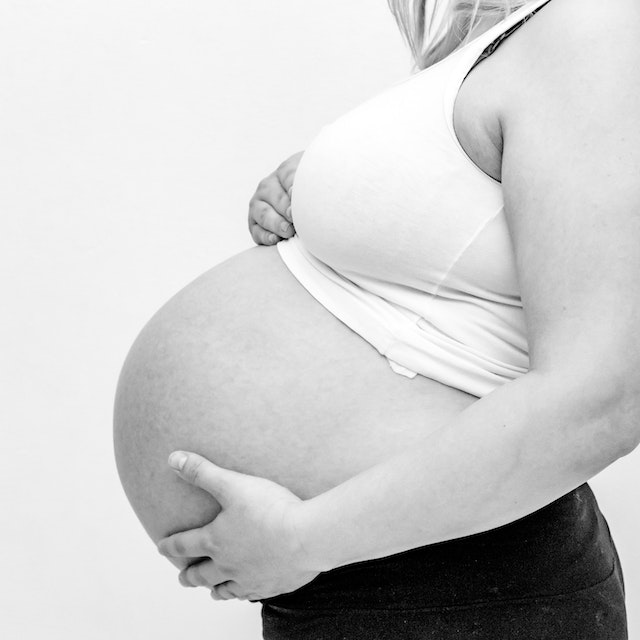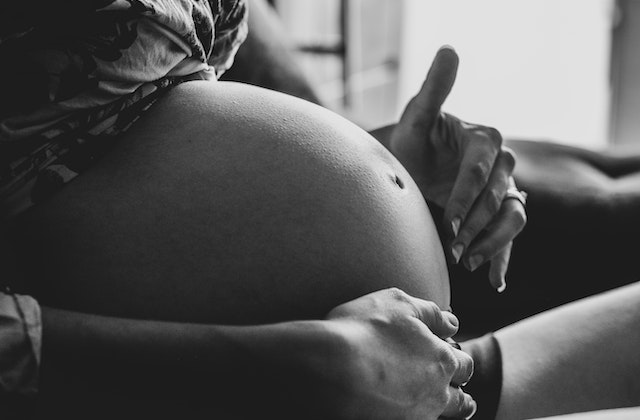
A “B-belly” pregnancy refers to a distinct shape where the pregnant belly appears divided into two halves, resembling the letter “B.” It is also sometimes referred to as a double pregnancy belly. This differs from the more common D-belly shape, which resembles the letter “D” and lacks the divided pattern.
In this article, we will explore the concept of B-Belly pregnancy, its symptoms, and how to manage it. Let’s delve into the details and learn more about this unique aspect of pregnancy.
Is B-Belly Pregnancy Common?
Indeed! A B-belly pregnancy is a completely normal occurrence during pregnancy, and it is quite common. There is absolutely no need to worry if you have a B-shaped belly instead of the traditional D-shaped one. Pregnancy bumps come in a variety of sizes, shapes, and colors, and each one is unique and beautiful in its way. Embracing and celebrating your pregnancy’s belly shape is a wonderful way to appreciate the beauty of your journey. So, remember to embrace your B-belly with pride and joy!
Can A B-Belly Eventually Turn To D-Belly Pregnancy?
During pregnancy, the typical shape of the belly is a large curve resembling the letter ‘D’. This curve starts small, gradually grow larger, and eventually encompasses the mother’s body. However, in the case of a B-belly pregnancy, two curves resemble the letter ‘B’. It is more commonly observed in plus-size pregnant women.
As the pregnancy progresses and the baby grows, the indentation between the two curves of the B-shaped belly will be filled, eventually transforming it into a D-shaped belly. Some women humorously remark that they are ready to deliver once their B-shaped belly becomes D-shaped.
However, it’s important to note that for some women, their belly may maintain a B-shape throughout the pregnancy until they give birth. As every woman’s body is unique, not everyone will experience the complete transformation into a D-belly shape.
Is B-Belly Pregnancy Risky?
Having a B-belly pregnancy does not have any impact on the stages of pregnancy or the type of birth you will have. The occurrence of a B-shaped belly does not determine the labor process or the type of delivery.
However, it is important to note that for women with a larger lower abdominal area, some additional care may be required during the recovery period after a C-section. This is because the specific shape of the B-belly may affect the incision site and require special attention during the healing process.
What Is The Cause For B Belly?

The exact cause of a B-belly in pregnancy is not specific and can vary from person to person. While B-bellies are more commonly observed in individuals with higher body weight, they can occur in individuals of any body size and shape. Several factors, such as height, weight, muscle tone, and bone structure, contribute to how a pregnancy bump is carried.
The following factors can contribute to the development of a B-belly:
- Fascial Health: The condition of the connective tissues beneath the skin, known as fascia, can affect the shape of the belly. Damaged fascia due to factors like a sedentary lifestyle, dehydration, poor posture, imbalanced diet, stress, or muscle injuries may contribute to a B-belly appearance. Regular stretching, staying hydrated, and incorporating exercises like yoga or cardio into the routine can help maintain healthy fascia during pregnancy.
- Body Size and Weight: Women with higher body weight, indicated by a body mass index (BMI) of 25 to 29.9 (overweight) or 30 and above (obese), may be more prone to developing a B-belly during early pregnancy. However, it is important to note that this is not a guarantee and can vary among individuals.
- Prior Pregnancies: Women who have had previous pregnancies may experience looser stomach muscles and a quicker expansion of their shape during subsequent pregnancies. This can contribute to the development of a B-belly, particularly if the pregnancies are close together or if the body has not fully returned to its pre-pregnancy shape before becoming pregnant again.
- Usual Belly Shape: Women with an apron belly or those who carry weight primarily in their belly region, rather than in their hips and thighs, may be more likely to develop a B-belly during pregnancy, even if they have not been pregnant before.
- Diastasis Recti: Diastasis recti refers to the stretching and separation of the abdominal muscles, leading to a gap between them. This condition occurs due to increased internal abdominal pressure during pregnancy, causing the abdominal size and tissues to enlarge and stretch. The widening gap between the right and left sides of the abdomen can contribute to the appearance of a B-belly.
It’s important to remember that each person’s body is unique, and the shape of the belly during pregnancy can vary. Embracing and celebrating your body’s changes during pregnancy is essential, regardless of the belly shape you experience.
Symptoms Of B-Belly Pregnancy
B-Bellies may not be easily noticeable until after childbirth, as they can be more challenging to distinguish during pregnancy when there is a stretch in the abdomen. However, some symptoms may indicate the presence of a B-belly:
- Difficulty in walking or performing everyday tasks: The altered shape and distribution of weight in a B-Belly pregnancy can affect mobility and make certain movements or activities more challenging.
- Lower back pain: The changes in abdominal shape and posture associated with a B-Belly can contribute to lower back pain or discomfort.
- Visible bulge above or below the belly button: A distinct bulge may be visible either above or below the belly button, indicating the presence of a B-belly.
- Constipation: The altered abdominal shape and pressure from the growing uterus can affect bowel movements, leading to constipation in some cases.
- Pain in the hips: The changes in posture and weight distribution associated with a B-Belly pregnancy can put additional strain on the hips, leading to hip pain or discomfort.
- Weakness in the abdomen: The separation of abdominal muscles (diastasis recti) that often occurs in a B-Belly pregnancy can result in a feeling of weakness in the abdominal area.
- Leakage of urine when sneezing or coughing: The weakened abdominal muscles and increased pressure on the pelvic floor in a B-Belly pregnancy may contribute to urinary incontinence, causing leakage of urine during sneezing or coughing.
- Poor posture: The altered abdominal shape and weakened abdominal muscles can affect overall posture, leading to a less optimal alignment of the spine and posture-related issues.
It’s important to note that experiencing these symptoms does not necessarily mean a B-Belly is present, and individual experiences may vary. If you have concerns or experience discomfort during pregnancy, it’s advisable to consult with a healthcare professional for proper evaluation and guidance.
Does B-Belly Pregnancy Ever Go Away?
This varies with each woman; for some, the b-belly may remain until delivery while it may disappear for others.
From the first to the third trimester, all bellies develop in different shapes and sizes. As the pregnancy progresses, the weight shifts and adjusts, and the B shape becomes less obvious. If you are lucky, it can even transform into a D-shaped belly.
Mustela explains the stages in Pregnancy Belly Stages: Size, Shape, and What to Expect
How To Make B-Belly Pregnancy Go Away

To address a B-Belly and promote healing, incorporating gentle movements that engage the abdominal muscles is recommended. However, it is crucial to consult with a fitness professional before starting any exercise regimen. This is to ensure safety and create a suitable plan.
During the postpartum period, it is advised to avoid heavy lifting. Also, adopt a side-rolling technique when getting out of bed or sitting up. Using the arms to assist in pushing up is beneficial. Activities that cause the abdomen to protrude, such as crunches and sit-ups, should be avoided.
Some individuals may choose to use binding devices to support their bellies. It is important to note that this won’t directly heal the B-Belly. Instead, it can serve as a reminder to maintain good posture.
In cases of severe hernia or when a woman desires a tummy tuck surgery, surgical procedures may be considered. However, the decision to undergo surgery should be discussed with a healthcare professional, taking into account individual circumstances and preferences.
When To Worry About B-Belly Pregnancy
A B-belly pregnancy itself does not typically raise concerns for doctors. However, if weight is the underlying factor contributing to the B-Belly, your doctor may want to address additional health considerations. Being overweight during pregnancy increases the risk of gestational diabetes, high blood pressure, miscarriage, stillbirth, and back pain.
In addition to the physical health concerns, there are emotional aspects to consider when experiencing a B-Belly pregnancy. It is important to recognize that whatever emotions you may be feeling are completely normal and valid.
It’s crucial to remember that everybody is unique. Your body is working hard to support both you and your baby. Embracing self-acceptance and understanding that your body is fulfilling its natural function can provide comfort during this time.
What To Wear To Cover B-Belly Pregnancy
Finding suitable maternity clothes that accommodate a B-Belly pregnancy can sometimes be challenging, as form-fitting garments may accentuate the bump. However, there are options to help conceal the B-shaped belly and feel comfortable during pregnancy.
Using belly bands can be an effective way to hide the B-belly shape. They can be combined with plus-size baby-doll tops or maternity dresses that are flowy below the bust area. Retailers like Bella Mama offer a range of maternity tops with extra lengths designed to conceal the B-shape. By opting for these types of maternity clothes, you can proudly showcase your pregnancy without worrying about the visibility of the B-belly.
It’s essential to remember that having a B-shaped belly during pregnancy is entirely normal and beautiful. The primary focus during pregnancy should be on maintaining your and your baby’s health. Embracing the natural changes in your body and celebrating the journey of pregnancy is the key.
Other Things To Note About B-Belly Pregnancy
It is worth noting that the level of fitness can also influence the shape of a pregnancy belly. Women with well-defined abdominal muscles and a toned tummy may experience a less pronounced belly protrusion. Especially in the early stages of pregnancy. Generally, fitter women tend to carry their pregnancy bumps higher and closer to their bodies.
The shape of the pregnancy bump can also be influenced by the strength and laxity of the abdominal muscles. If the muscles are more relaxed, the belly may appear broader and lower. The position of the baby inside the womb can also contribute to the shape of the belly. For instance, a high pregnancy belly can be attributed to the baby’s position. It can shift upwards when the placenta is positioned higher in the body.
While most mothers typically develop a D-shaped belly during pregnancy, a few can have a pear-shaped or B-shaped belly. Nowadays, alongside concerns about their babies’ health, some mothers also worry about the shape of their belly and desire a more traditional D-shaped pregnancy belly rather than a B-belly pregnancy.
Conclusion
When you imagine a pregnant body, the image of a cute, round bump often comes to mind. However, if you speak to individuals who have experienced a B-belly pregnancy and embraced it, they will assure you that there is nothing to worry about.
If you find yourself with a bump that resembles the letter B, know that you are not alone. It is not uncommon for the shape of your bump to change during pregnancy, and even if it does, there is no cause for concern.
While B-belly pregnancies are considered normal, if you have any concerns or if something feels off, it is always a good idea to discuss them with your doctor.
Regardless of your body size before pregnancy, every baby bump is unique in terms of when it appears and how it looks. Embrace the individuality of your pregnancy journey and celebrate the beauty of your unique bump.
Leave a Reply
You must be logged in to post a comment.